COSMOSIL Sugar-D
Features

- Different selectivity from aminopropyl columns
- Superior quantitative results
- Superior durability
- Anomers remain unseparated
Product Information
Column Specifications
Features
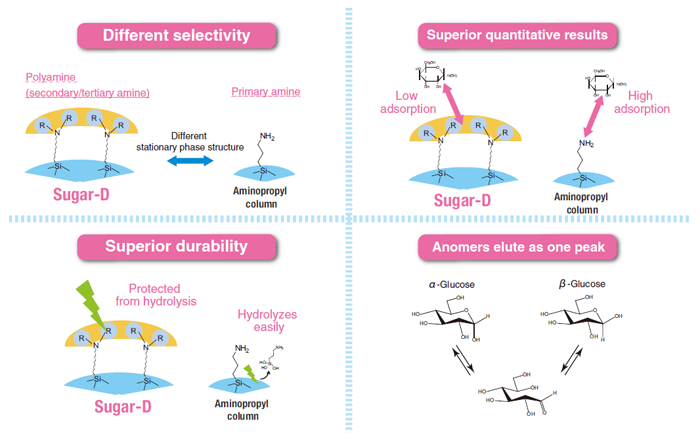
About Sugar-D
Development of Sugar-D
Aminopropyl columns are commonly used for analysis of monosaccharides and oligosaccharides; however, this type of column has several problems, including low durability, poor separation, and adsorption and peak tailing with some analytes. Carbamoylbased columns separate anomers, which may not be desirable. To solve these problems, we developed a specialty column for sugar analysis with high durability and performance that does not induce irreversible adsorption.
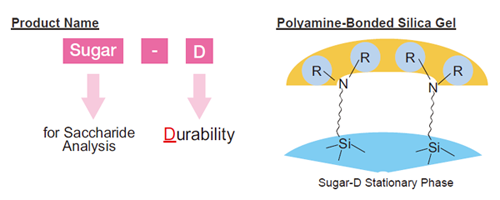
Different selectivity from aminopropyl columns
COSMOSIL Sugar-D has a polyamine-based stationary phase, which results in different selectivity from primary anime-based phases, such as aminopropyl.
Comparison to aminopropyl columns
• Sucrose and Turanose
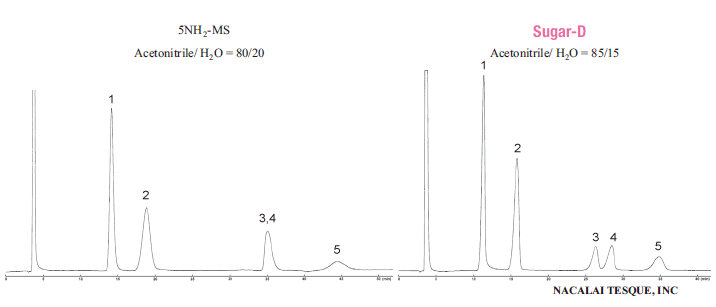
| Condition | |||||||||||
|---|---|---|---|---|---|---|---|---|---|---|---|
| Column Size | 4.6 mm I.D. x 250 mm | ||||||||||
| Flow Rate | 1 ml/min | ||||||||||
| Temperature | 30°C | ||||||||||
| Detection | RI | ||||||||||
| Sample |
|
||||||||||
| Inj.Vol. | 17µl | ||||||||||
Superior quantitative results
Aldehyde groups in the open-chain form of sugars can form Schiff bases with the amino groups on aminopropyl columns, causing low recovery and peak tailing. COSMOSIL Sugar-D was designed to avoid this, so sugars like arabinose and galactose, which are problematic on aminopropyl columns, elute with sharp peaks. Sugar-D is especially useful for samples of low concentration.
Quantitation at low concentration
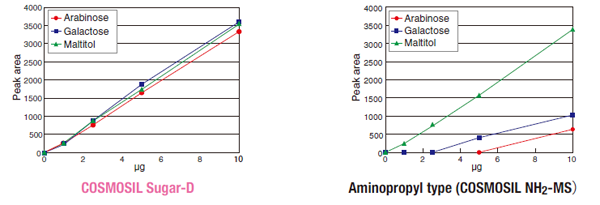
Superior durability
The stationary phase of COSMOSIL Sugar-D is not easily hydrolyzed, so even using water as the mobile phase does not affect it much.
Change in retention factor
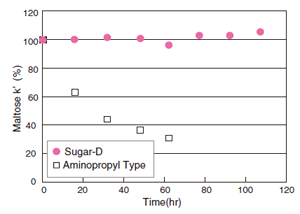
| Eluent Condition | |
|---|---|
| Eluent | Water |
| Flow Rate | 1 ml/min |
| Temperature | RT |
| Test Condition | |
|---|---|
| Column Size | 4.6 mm I.D. x 250 mm |
| Mobile Phase | Acetonitrile : Water = 70 : 30 |
| Flow Rate | 1.0 ml/min |
| Temperature | 30°C |
| Detection | RI |
| Sample | Maltose |
Anomers remain unseparated
When analyzing sugars with amide columns, anomers may separate unless harsh conditions, such as high temperature and basic solvents, are employed. COSMOSIL Sugar-D does not separate anomers, even under mild conditions.
Comparison to amide column
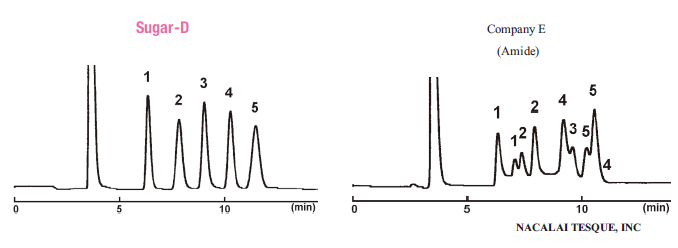
| Test Condition | |||||||||||
|---|---|---|---|---|---|---|---|---|---|---|---|
| Column Size | 4.6 mm I.D. x 250 mm | ||||||||||
| Mobile Phase | (Sugar-D) Acetonitrile / H2O = 80/20 (Company E) Acetonitrile / H2O = 75/25 |
||||||||||
| Flow Rate | 1.0 ml/min | ||||||||||
| Temperature | 30°C | ||||||||||
| Detection | RI | ||||||||||
| Sample |
|
||||||||||
Applications
Analysis of Carbohydrate Mixtures by COSMOSIL Sugar-D
We have compiled a list of our Sugar-D HPLC application data in an easy-to-read format. Please click the compound name to view its data.
| Coumpound | CAS No. | No. of applications |
|---|---|---|
| D-(+)-Glucose | 50-99-7 | 11 |
| D-(-)-Fructose | 57-48-7 | 9 |
| Xylitol | 87-99-0 | 4 |
| D-Psicose | 551-68-8 | 3 |
| Sucrose | 57-50-1 | 7 |
| Maltose | 6363-53-7 | 5 |
| D-(+)-Raffinose | 17629-30-0 | 2 |
| D-(+)-Mannose | 3458-28-4 | 2 |
| L-(+)-Rhamnose | 10030-85-0 | 2 |
| D-(+)-Trehalose | 6138-23-4 | 1 |
| D-(+)-Allose | 2595-97-3 | 1 |
| D-Glucitol | 50-70-4 | 3 |
| Maltitol | 585-88-6 | 3 |
| meso-Erythritol [meso-Erythrite] | 149-32-6 | 3 |
| myo-Inositol | 87-89-8 | 2 |
| Cyclodextrins | 10016-20-3 7585-39-9 17465-86-0 |
1 |
| D-Glucuronic Acid | 6556-12-3 | 1 |
| Glycerol | 56-81-5 | 1 |
| 1-Kestose | 470-69-9 | 1 |
| Lactose | 5989-81-1 | 1 |
| Maltotriitol | 32860-62-1 | 2 |
| Maltotriose | 1109-28-0 | 2 |
| Maltotetraose | 34612-38-9 | 1 |
| Maltopentaose | 1668-09-3 | 1 |
| Maltohexaose | 34620-77-4 | 1 |
| Maltoheptaose | 34620-78-5 | 1 |
| D-(-)-Mannitol | 69-65-8 | 1 |
| D-Mannosamine | 5505-63-5 | 1 |
| Nystose | 13133-07-8 | 1 |
| Palatinit | 64519-82-0 | 1 |
| Palatinose | 13718-94-0 | 1 |
| D-(+)-Xylose | 58-86-6 | 1 |
| 1-Fructofuranosyl-D-nystose | 1 | |
| Fructooligosaccharides | 1 | |
| Isomaltooligosaccharides | 1 | |
| Maltotertaitol | 1 | |
| Xylooligosaccharides | 1 |
Sugars in Sports Drinks
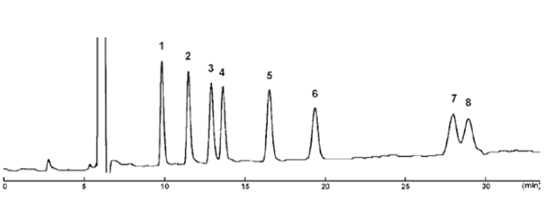
| Condition | |||||||||||||||||
|---|---|---|---|---|---|---|---|---|---|---|---|---|---|---|---|---|---|
| Column Size | (4.6 mm I.D. x 250 mm) x2 | ||||||||||||||||
| Mobile Phase | Acetonitrile/ H2O = 75/25 | ||||||||||||||||
| Flow Rate | 1.0 ml/min | ||||||||||||||||
| Temperature | 50°C | ||||||||||||||||
| Detection | RI | ||||||||||||||||
| Sample |
|
||||||||||||||||
Honey
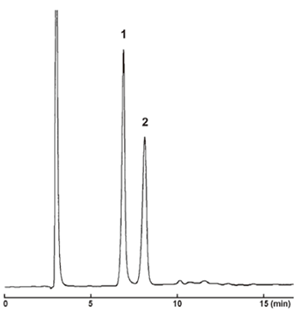
| Condition | |
|---|---|
| Column Size | 4.6 mm I.D. x 250 mm |
| Mobile Phase | Acetonitrile/ H2O = 75/25 |
| Flow Rate | 1.0 ml/min |
| Temperature | 30°C |
| Detection | RI |
| Sample | Honey (50mg/ml) 1; D-(-)-Fructose 2; D-(+)-Glucose |
| Inj.Vol.: | 5.0µl |
Sugar Alcohols
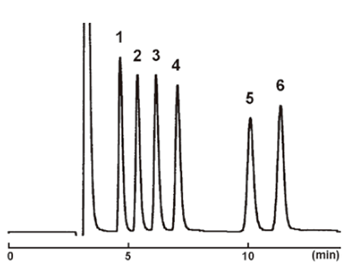
| Condition | |||||||||||||
|---|---|---|---|---|---|---|---|---|---|---|---|---|---|
| Column Size | 4.6 mm I.D. x 250 mm | ||||||||||||
| Mobile Phase | Acetonitrile/ H2O = 75/25 | ||||||||||||
| Flow Rate | 1.0 ml/min | ||||||||||||
| Temperature | 30°C | ||||||||||||
| Detection | RI | ||||||||||||
| Sample |
|
||||||||||||
Maltooligosaccharides
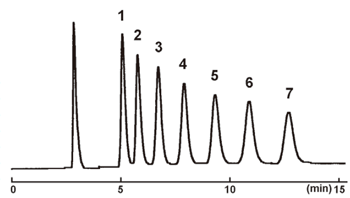
| Condition | |||||||||||||||
|---|---|---|---|---|---|---|---|---|---|---|---|---|---|---|---|
| Column Size | 4.6 mm I.D. x 250 mm | ||||||||||||||
| Mobile Phase | Acetonitrile/ H2O = 65/35 | ||||||||||||||
| Flow Rate | 1.0 ml/min | ||||||||||||||
| Temperature | 30°C | ||||||||||||||
| Detection | RI | ||||||||||||||
| Sample |
|
||||||||||||||
Usage information
| Column | 5 µm Sugar-D | ||||
|---|---|---|---|---|---|
| I.D. (mm) | 2.0 | 3.0 | 4.6 | 10.0 | 20.0 |
| Washing method |
| ||||
| Storage conditions | Wash the column to remove buffer, salts and/or acid. Then, replace the solvent with 90:10 acetonitrile/water. Tightly plug the column, and store in a cool and dry place. |
||||
| Usable pH range | pH 2 - 7.5 | ||||
| Max. pressure | 20MPa | 15MPa | |||
| Temperature range | The maximum usable temperature is 60°C. However. for regular use, please use at a constant temperature between 20°C and 50°C. | ||||
| Usable solvents | Acetonitrile/water mobile phases are recommended. | ||||
| Other instructions |
|
||||
Inseparable Compounds
Some sugars are not separated well by Sugar-D. For these compounds, you can use COSMOSIL NH2-MS.
| Compound pair | NH2 application | |
|---|---|---|
| Glucose | Galactose | AP-0137 |
| Lactose | Maltose | AP-0138 |
You can search for others in our application search. The Sugar-D chromatogram index (applications beginning "K-") can help you determine analysis conditions.
Downloads
References
Reference list
Ordering Information
Analytical and Preparative Column (Particle size : 5 µm)
COSMOSIL Sugar-D
| Product Name | Size | Product No. | Price |
|---|---|---|---|
| COSMOSIL Sugar-D Guard Column | |||
| 4.6 mm l.D. x 10 mm | 05394-81 | ||
| 10 mm l.D. x 20 mm | 05696-31 | ||
| 20 mm l.D. x 50 mm | 05694-51 | ||
| COSMOSIL Sugar-D Guard Cartridge Guard cartridge holder is required. |
4.6 mm l.D. x 10 mm | 19185-04 | |
| COSMOSIL Sugar-D Packed Column | |||
| 2.0 mm l.D. x 250 mm | 05689-31 | ||
| 3.0 mm l.D. x 150 mm | 05690-91 | ||
| 3.0 mm l.D. x 250 mm | 05691-81 | ||
| 4.6 mm l.D. x 150 mm | 05395-71 | ||
| 4.6 mm l.D. x 250 mm | 05397-51 | ||
| 10 mm l.D. x 250 mm | 05692-71 | ||
| 20 mm l.D. x 250 mm | 05693-61 |
(Storage) RT: Room temperature, A: Cool and dark, R: Refrigerator, F: Freeze









